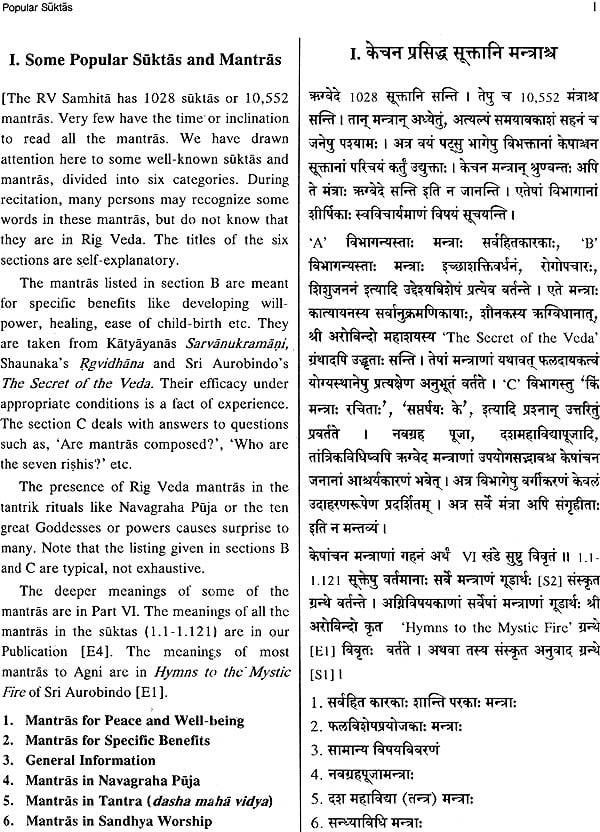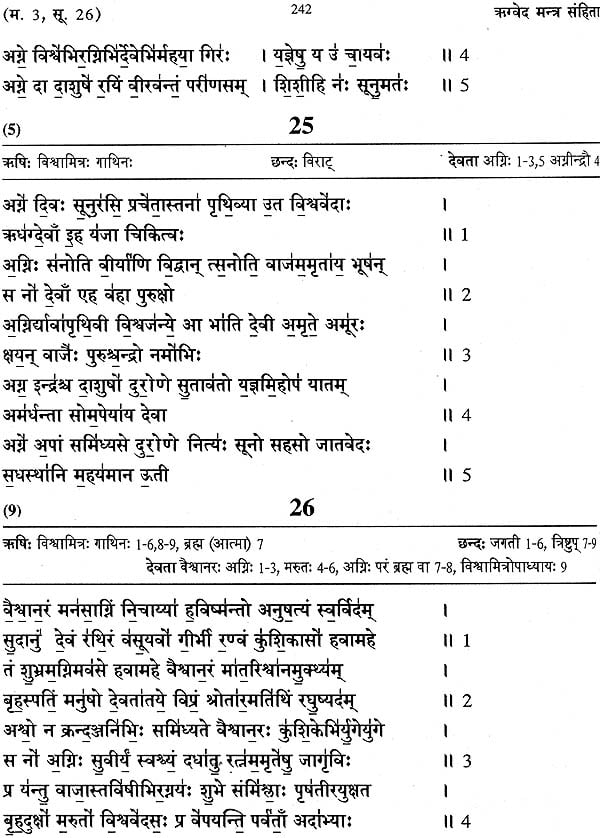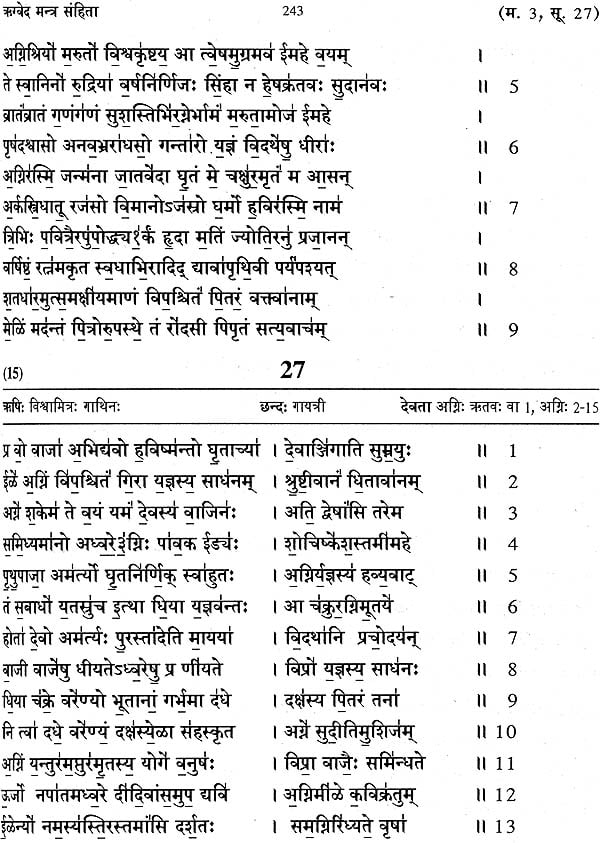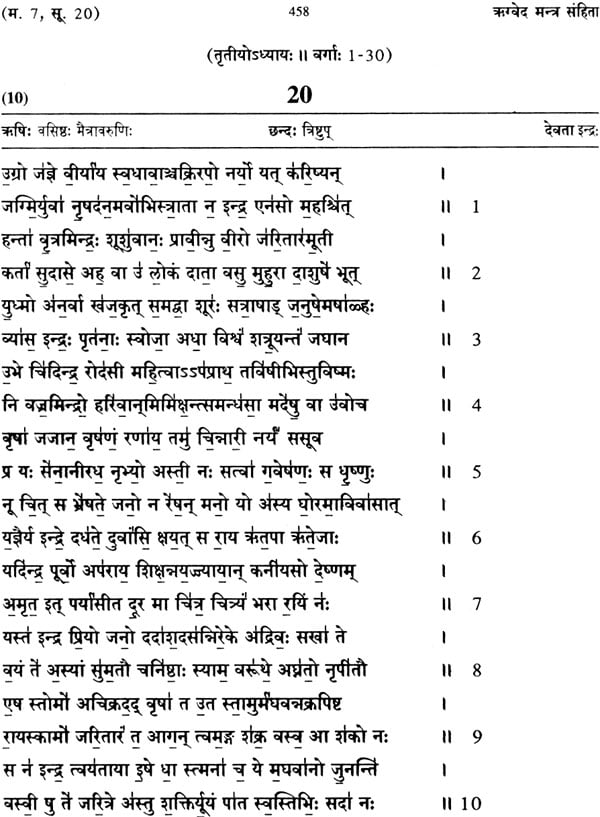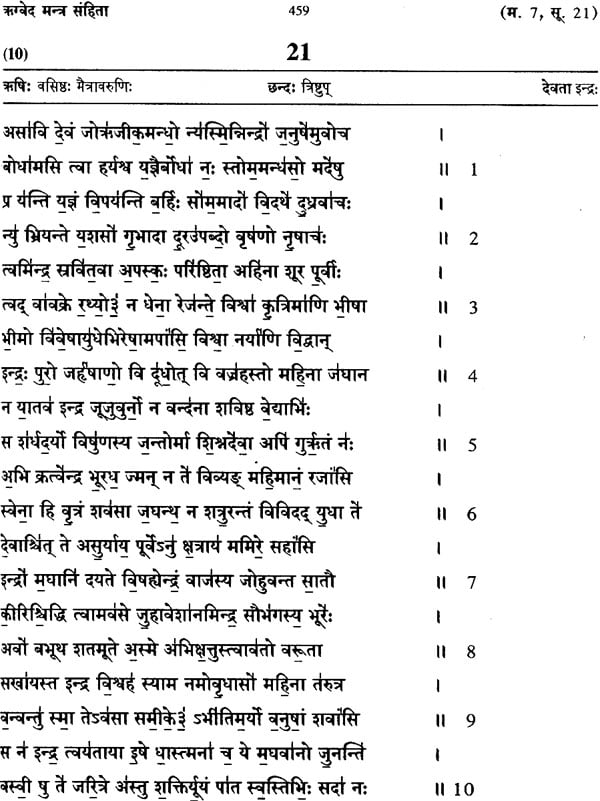
ऋग्वेद मन्त्र संहिता: Rig Veda Mantra Samhita
Book Specification
| Item Code: | NZG018 |
| Author: | आर. एल. कश्यप (R. L. Kashyap) |
| Publisher: | Sri Aurobindo Kapali Sastry Institute of Vedic Culture |
| Language: | Sanskrit Only |
| Edition: | 2018 |
| ISBN: | 9788179940211 |
| Pages: | 976 |
| Cover: | Hardcover |
| Other Details | 10.0 inch X 7.5 inch |
| Weight | 1.40 kg |
Book Description
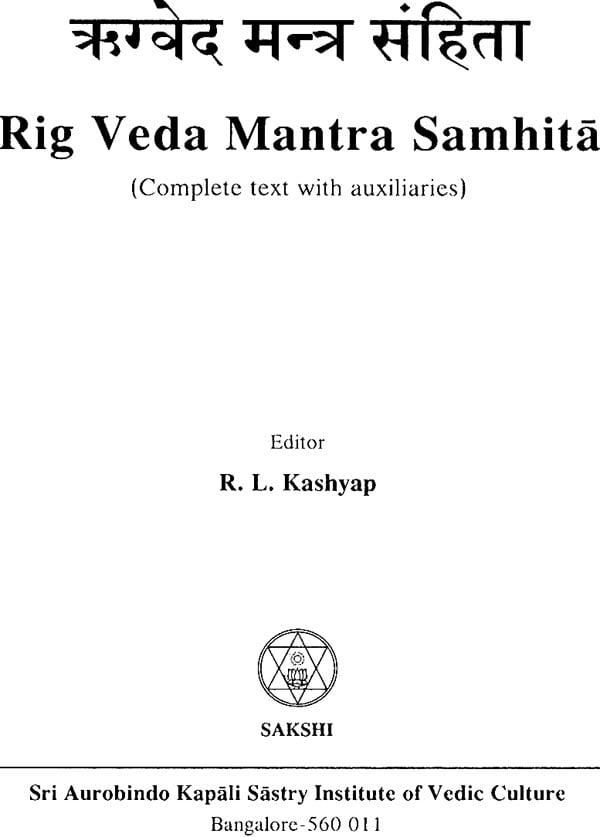
Dr. R.L. Kashyap is Professor Emeritus of Electrical and Computer Engineering at Purdue University, Lafayette, Indiana in USA. He had his Master’s degree from Indian Institute of Science, Bangalore and obtained ph. D. from Harvard University. He is the recipient of many International awards. In 2003 he has received ‘Vedanga Vidvan’ award instituted by Maharshi Sandipani Vedavidya Pratishthan (Ujjain), an autonomous body of HRD, Govt. of India.
He has authored more than 350 research articles of which 220 are published in scholarly journals and the rest were presented at conferences. He has guided above 50 doctoral students.
He has written extensively on Veda. Some of his widely read books on Veda are : ‘Krishna Yajur Veda Taittiriya Samhita’ (4 Volumes), ‘Rig Veda Samhita’- (12 Volumes), ‘Sama Veda’ (2 Volumes),’ ‘Atharva Veda’ (6 Volumes), ‘Why Read Rig Veda’, ‘Rudra Mantras’, ‘Essentials of Rig Veda’, ‘Essentials of Yajur Veda’, ‘Essentials of Sama Veda’, ‘Work, Enjoyment & Progress’.
He is the Founder and the Honorary Director of Sri Aurobindo Kapali Sastry Institute of Vedic Culture, Bengaluru.
Rig Veda Samhita is not only the oldest text of the Hindus, but also perhaps the oldest available religious or secular work in the entire world according to many scholars. In the Indian spiritual tradition spanning over several millennia, the roots of all knowledge and wisdom are traced to the four Veda Samhitas, Rig Veda, Yajur Veda, Sama Veda and the Atharva Veda. The books like the Upanishads, Brahmanas, that came long after the Veda Samhitas declare that all knowledge like grammar, philosophies, the different methods of yoga, rituals, mathematics etc., are the flowerings of the seeds in the Samhita books.
Rig Veda is the earliest book which develops the idea of the all-encompassing spirit which it calls as the One or the One Existent which cuts across all the barriers of birth, learning, occupation, sex and family status and which does not conflict with the idea of the many. This spirit, the One, can be realized by all persons.
As Sri Aurobindo observes, " .... they [the Vedic sages] may not have yoked the lightning to their chariots, nor weighed sun and star, nor materialised all the destructive forces in Nature to aid them in massacre and domination, but they had measured and fathomed all the heavens and earths within us, they had cast their plummet into the inconscient and the subconscient and the super conscient; they had read the riddle of death and found the secret of immortality; they had sought and discovered the One and known and worshipped Him in the glories of His light and purity and wisdom and power ..... "
We have tried to bring out an aesthetically pleasing and user-friendly edition aimed at three classes of readers namely the beginners who have only heard the mantras like the Gayatri of sage Vishwamitra, the Ganapati mantra etc., and want to know more, those familiar with the Rig Veda needing a delightful edition for chanting and study, and finally those with inquisitive minds who, having read in translations or heard in discourses that Rig Veda is nothing but a book of rituals devoid of wisdom, want to find the Truth for themselves directly from the original text.
The book is divided into seven parts. The first part gives a list of well-known Suktas and mantras in the Rig Veda. We may recall that Rig Veda has 10,552 mantras. Not everyone has the time or interest to study all of them. Some of the readers may be surprised to know that many of the popular mantras they have heard in rituals like Sandhya or Navagraha Puja are actually in Rig Veda Samhita. As per some requests, we have included mantras with specific benefits such as freedom from disease and fear, child-birth etc.
Part II carries seven introductory essays answering commonly encountered questions regarding the Rishi, the devata, the yajna and the essence of the Rig Veda. We stress that Rig Veda does not have the details of even a single ritual. The names of rituals are symbolic.
The seventh essay in Part II with the title, "The Secret of the Veda in Aphorisms", is authored by Shastra- Chudamani, Veda Kamala Professor S.K. Ramachandra Rao. These aphorisms are based on the famous commentary elucidating the secrets in the Rig Veda entitled, "Siddhanjana", by Sri T.V. Kapali Sastry. The aphorisms use the excerpts from the book by TVK. We give both the original Sanskrit work and its English translation.
Since many Hindus trace their lineage to a Rishi, many persons have wanted to know the Rig Veda mantras associated with the Rishis of their lineage. In part III, we give the names, of major contributors like Atri, Vishvamitra, Kanva, Vasishtha etc. In the appendix we give an alphabetical list of all the Rishis numbering about 400 and their associated suktas. We have included a list of women Rishis of the Rig Veda. It is not out of place to note that some women had the status of Rishi, they had the revelation of the mantras and could chant all the mantras.
Part IV contains the complete text of one shakha or branch of Rig Veda entitled Shakala. The text has 1028 hymns or suktas (including the Valakhilya suktas) or 10552 mantras or verses divided into 10 Mandalas. The Mandalas two through seven are associated with the families of the Rishis Grtsamada, Vishvamitra, Vamadeva, Atri, Bharadvaja and Vasishta. The ninth Mandala is dedicated to the deity Soma, the Lord of Delight, Ananda. The remaining three Mandalas, one, eight and ten have multiple authors and are dedicated to several deities. The suktas of Rig Veda are grouped into 8 Ashtakas also. The concordance between the numbering in the Ashtaka and Mandala systems is given in the beginning of Part IV.
The text is in the Devanagari script with modern (Hindu) numerals. The Rishi, Chhandas and Devata information of each Sukta is in a block. The number on the top of the left-hand side of the block is the number of mantras in that Sukta. The number of the Sukta is given in boldface and bigger font above the middle part of the block.
The text is taken from standard editions. As noted by the great scholar Pandit Satawalekar, there are only two different variants among all the numerous reliable manuscripts and these two differ from each other in only one syllable in a text of more than three hundred thousand syllables. This level of accuracy has been possible because of the special methods of chanting called Ashtavikrit which have error detection and correction capabilities.
Part V contains the set of Khila Sukta. Different texts have different sets of Khila Suktas with many common hymns. The text given here is based on the critical edition produced by the Vaidika Samshodhana Mandala (VSM) Pune and Dr. C.G. Kashikar. As the introductory essay in the VSM edition states, all these Khila Suktas belong to the four other nearly extinct Rig Vedic shakhas namely Bashkala, Ashvalayana, Shankhayana, (or Sankhyayana) and mandukayana.
Part VI consists of translation of a hundred mantras and their commentary. They are taken from the book titled, ‘Gems from the Vedas’ authored by the Late Sri Madhav Pandit. A few more verses have been inserted by us. The translation itself is due to Sri Aurobindo. This sample should give the reader a glimpse into the depth of the ideas in Rig Veda and prompt him/her to read the original works of Sri Aurobindo and Sri kapali Sastry on the Rig Veda. We are grateful to Sri Shradddhalu Ranade of Dipti Trust for giving us the permission to reprint from the above mentioned book.
Part VII has several appendices. The appendix one gives the lists of mantras for several topics. The appendix two gives the concordance between the mantras of Rig Veda and Krishna Yajur Veda. Some persons who style themselves traditionalists (sampradayikas) declare that a person belonging to Rig Veda should not study the Yajur Veda and vice versa. They are not aware that about one third of the mantras are common to both of them. The appendix three gives the list of names of all the Rishis in Rig Veda and the specific Suktas associated with each Rishi. We are grateful to Vaidika Samshodhana Mandala for the use of this material. The appendix four gives the listing of all the books which are quoted in this book.
We are grateful to His Holiness Sri Rangapriya Swamiji for blessing this book with 'Ashirvachana'. We are grateful to Professor S.K. Ramachandra Rao. for helping us in several ways in the dissemination of the Vedic knowledge and for preparing the Aphorisms in Sanskrit entitled, "Veda Gudhartha Bodha Sutrani" and their English rendering 'Secret of the Veda in Aphorisms', both of them are in this book.
We are grateful to the staff of SAKSIVC for their outstanding help. Particular mention should be made of Vidvan S. Ramaprasad who proofread the text, Sri G.P. Dharanendra Kumar who did the computer data entry and Sri B.S. Raghottamachar for editorial assistance. We are also grateful to Sri Balakrishna and the staff of Sreeranga Printing and Publishing House for printing the book beautifully.
| Ashirvachana | viii | |
| Preface | ix | |
| I | Some popular Suktas and Mantras | 1 |
| 1 | Mantras for Peace and Well-being | 2 |
| 2 | Mantras for Specific Benefits | 2 |
| 3 | General Information | 4 |
| 4 | Mantras in Navagraha Puja | 6 |
| 5 | Mantras in Tantra (dasha maha vidya) | 6 |
| 6 | Mantras in Sandhya Worship | 7 |
| II | Introductory Essays on Rig Veda | 9 |
| 1 | Overview of Rig Veda | 9 |
| 2 | Rishis | 11 |
| 3 | Mantra, Metre and Accent marks | 13 |
| 4 | Vedic Gods | 15 |
| 5 | Brahma, Vishnu and Rudra-Shiva | 17 |
| 6 | Yajna | 19 |
| 7 | Secret of the Veda in Aphorisms | 20 |
| III | Names of Rishis | 23 |
| IV | Text of Rig Veda Mantra Samhita (1,028 suktas, 10,552 mantras) | 26 |
| V | Text of the Rig Veda Khila Suktas | 845 |
| VI | A Hundred Mantras : Text in Devanagari & Roman with Meaning | 896 |
| VII | Appendices | 945 |
| 1 | Topical Index of Contents of Mantras | 945 |
| 2 | Concordance between Rig Veda and Yajur Veda | 950 |
| 3 | Index of the Rishis of Rig Veda | 957 |
| 4 | References | 961 |
